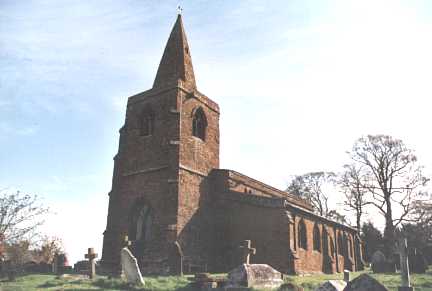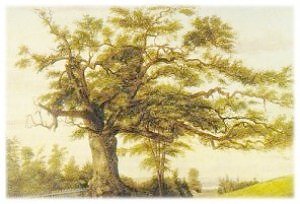THE RICHARD WYLLYS FAMILY
|
|

RICHARD WYLLYS
Generation 4
RICHARD WYLLYS, Esq. was born in 1573 at Fenny Compton. He married HESTER CHAMBERS, of Williamscote, Oxfordshire, England, born in 1567. She was the daughter of George Chambers and Judith Calcott.
Richard died on June 10th, 1597. His wife died after 1597. Richard, and presumably his wife, along with Richard’s parents, are buried at the Church of St. Peter and St. Clare at Fenny Compton, built in the 14th century. The inscription upon Richard’s tomb is in the chancel of the church:
“Here lyeth bvried the bodie of Richard Willis of Fenny Compton in the covntye of Warwicke gent., sonne of Ambrose Willis deceased which said Richard had by Hester his wife five children that is to say George William Richard Judithe and Marie all now lyving who deceased the tenth day of June 1597.”
Dugdale’s Warwickshire gives the inscriptions on the tombs of Richard and his father and grandfather.
CHILDREN of RICHARD & HESTER (CHAMBERS) WYLLYS
All born at Fenny Compton, Warwick, England
- GEORGE WYLLYS, born 1589/90. He married Bridget Young.
- William Wyllys, born about 1591.
- Judithe Wyllys, born about 1595.
- Mary Wyllys, born about 1596.
- Elizabeth Wyllys, born about 1598
- Richard Wyllys*, born about 1599; died 26 Oct 1626.
- Anne Wyllys*, born about 1600.
- Bridget Wyllys*, born about 1602. [* These three dates of birth are after the death of the father.]

GEORGE WYLLYS
EARLY GOVERNOR OF CONNECTICUT
Generation 5
GEORGE WYLLYS was born in 1589/90 at the manor of Fenny Compton, Warwickshire, England. This little village is located about 15 miles east of Stratford-on-Avon.
George’s family was an old one, and of considerable wealth. He attended several universities in England, but biographers make no mention of him graduating. His main focus in any training would have been to gain the necessary experiences and background to take his father's place as one of the landed gentry. It was probably during his university years or shortly thereafter that George Wyllys became a Puritan.
MARRIAGE
On November 2, 1609, he married BRIDGET YOUNG at Holy Trinity Church in Stratford-on-Avon. She was born in 1580, the daughter of Mary Bonner and William Young, of Gloucestershire. I may put something together about her lineage at a later time, as Bridget Young’s is an impressive ancestry of royalty.
|
In Camden’s Visitation of Warwickshire, in 1619, George Wyllys is described as living at Fenny Compton, aged 29, with his wife. Bridget died in 1629. Her burial is recorded: “Bridget, wife of George Willys, Gent. Was buried at Fenny Compton, March 11, 1629.”

George remarried, in 1631, Mrs. Mary Brisbey, widow of Alexander Bisbey. She was the daughter of Francis and Alice (Ferneley) Smith of Stratford-on-Avon, England. Her father had been bailiff, or Mayor, of Stratford. The local parish register records the baptism in February 1631 of a son, Samuel, to “George Willys, Gent. and Mary his second wife.”
In the first part of the 17th century, the Puritan element in Warwickshire had become strong. Even during Shakespeare’s lifetime, the corporation of Stratford-on-Avon had forbidden the performance of plays or interludes in the Guild-hall. Many called their fellow townsmen “Puritan Knaves,” or “recussant” (one who refused to attend services of the Church of England; a dissenter or nonconformist). The most distinguished Puritans in the neighborhood were the Earl of Warwick and Lord Say and Sele (who ended up in New England), and whose seat was at Banbury in Oxfordshire, just over the border from Warwickshire and very near Fenny Compton.
Mr. George Wyllys may have been involved in a patent, dated March 12, 1629, for land in New Hampshire along with Say and Sele, William Whiting and Robert Saltonstall. The wealth of this family, by today’s standards, was substantial. George Wyllys had been a partner with Saltonstall and Whiting in the Piscataqua patents, as recorded in the Massachusetts Records, I. 324. Whiting was connected with the Wyllys family by marriage to George’s daughter, Amy.
EMIGRATION TO AMERICA
At any rate, George and Mary Wyllys and their children immigrated to New England early in the 1630s. He left his business affairs in the hands of brothers, James and Nathaniel Fiennes, Esqs., of the family of Lord Say and Sele. The value of George’s estate in England is stated in old family papers to have equalled £500 per annum. English writers have stated that one must multiply such a sum by six in order to ascertain the worth of such an income in England in the latter half of the 20th century. He owned lands and houses in other places, such as Napton and in or near Stratford-on-Avon, at Old Stratford, Clopton, Wellcombe, Hodnel and Bishopton. The manor house no longer stands.
The family may have sailed from Bristol, to Boston, where they settled for a time. By 1634 George had been appointed an Assistant to the General Court of the Massachusetts Bay Colony, serving in that capacity through 1636. In that year he sent his steward, William Gibbons, to Hartford, along with twenty domestics and indentured servants, to buy lands and oversee the building of a house.
On April 6, 1638, George Wyllys and his wife, conveyed to Richard Smarte all their land in Old Stratford, Wellcombe, and Bishopton, in England. The eldest son, “George Willys, Jur.,” was one of the witnesses. It has been thought that George Jr. was left in England in possession of the manor of Fenny Compton; however, it is more probable that he went with the family to Connecticut and then returned to England, and the manor, remaining there until his death in 1670.
HARTFORD
The Wyllyses moved to Hartford in 1638. Theirs was the largest home lot of any of the early Hartford settlers, and one of the largest homes in Connecticut. The homelot covered the square between Main, Charter Oak, Governor, and Wyllys Streets. Governors Wyllys, Webster, Welles, and Hopkins all built homes along the same street, which was called Governor Street until, unfortunately, the name was changed to Popieluszko Court. What a foolish decision! On this square was the oak tree which in the next generation became the famous Charter Oak, the State Tree of Connecticut.
|
On April 11, 1639, George Wyllys was appointed Assistant to the General Court of the Colony of Connecticut and served as such through 1640. In 1641, he served as Deputy Governor, and then in 1642 he was elected Governor of the colony.
During Governor Wyllys’s one-year term as governor, there was a continuing rumor that the Narragansetts were going to form an alliance with several other Indian tribes, and try to destroy the English settlers. Connecticut had to keep itself in a state of military readiness. Wyllys and the General Court sent John Haynes and Edward Hopkins as their delegates to a meeting in Boston which eventually resulted in the Articles of Confederation between the colonies of Massachusetts Bay, New Haven, and Connecticut, answering a long-standing need for cooperation between the New England colonies. In December of 1642, the General Court created and passed the first penal code in Connecticut, naming twelve capital crimes.
After his term as governor expired, he again, in 1643-44, served as Assistant to the General Court of the Colony of Connecticut. He was also chosen in 1643 to be a Commissioner from Connecticut to The United Colonies of New England.
George Wyllys was one of several Hartford men, all of gentry status in England and of the highest rank in the new colony, who became the first proprietors of the town of Farmington, in Connecticut. They owned land there but did not become settled inhabitants. As one of the Hartford’s Original Proprietors, his name appears on the north elevation of the Founder's Monument the Center Church Burying Ground.
DEATH OF THE GOVERNOR
George Wyllys died in Hartford on 9 March 1645, just months before his two daughters married. His will, dated December 14, 1644, mentions the names of his sons George and Samuel, and daughters Hester and Amy, estate in Fenny Compton, lands in Wethersfield, and many surnames, including Whiting. At the time of his death, his estate, which included slaves, was greater than that of any other Connecticut resident until 1680. His wife, Mary, was living in 1655.
The Governor is buried in Hartford's Ancient Burying Ground. His enormous tomb is a replica, made in 1899, of the most elaborate kind of grave marker produced in 17th century Connecticut. Original period examples of such stones, which are memorials to families of the highest rank, can be found in Windsor and Saybrook. Matthew Griswold of Windsor is the only stonecutter known to have produced them. The stone is ornamented on one end with the Wyllys family coat of arms. The full Epitaph reads:
George Wyllys
Born 1590 in Fenny Compton Co.
Warwick England
Came to Hartford 1638
Deputy Governor of Connecticut 1641
and Governor 1642 Died March 9, 1645
Bridget Young his Wife
Died at Fenny Compton
March 1629 and is there Buried
Mary Smith his Second Wife
Died in Hartford.

The Wyllys home stood until 1827 when it was razed. Wyllys Street in Hartford is named after him.
CHILDREN BY BRIDGET YOUNG
- George Wyllys. He married Susannah Clark of Croton, Northamptonshire; they had 2 daughters and lived at Fenny Compton.
- Hester Wyllys. She married 17 October 1645, as his 2d wife, Capt. Robert Harding, who came with John Winthrop in 1630, and afterwards removed to Rhode Island. In November 1646, he sailed for England and in 1651, he was a merchant in London.
- AMY WYLLYS, married 30 October 1645, John Pynchon, the only son of William Pynchon, of Springfield, Massachusetts.
CHILD BY MARY SMITH BYSBIE
- Samuel Wyllys, born in Warwickshire, England in 1632; of Hartford 1653. The next year he was chosen Assistant under the charter of Charles II, and continued in office until 1685. He was extensively engaged in trade, and had an interest in several sugar plantations at Antigua. Some of his business dealings were with his brother-in-law, John Pynchon. His speculations proved disastrous and he became deeply involved in debt, so that pecuniary assistance was granted him by the General Assembly. He was for four years commissioner to the Congress of the New England colonies, and held other offices. He married (1) Ruth Haynes, the daughter of Governor John Haynes and his 2d wife Mabel Hariakenden. Samuel and Ruth had five children. The date of Ruth's death is unknown; but he remarried, secondly, Mrs. Mary Love, at Berwick, Mass., on 28 Nov 1688. Samuel Wyllys died at Hartford on 30 May 1709. Between George Wyllys, this Samuel, his son and grandson, the post of secretary of Connecticut was held in uninterrupted succession for 98 years.

AMY WYLLYS
Generation 6
AMY WYLLYS, married 30 October 1645, JOHN PYNCHON, the only son of William Pynchon, of Springfield, Massachusetts.
|
Go to the PYNCHON FAMILY |
REFERENCES
“Ancestry of Bridget Yonge....” The New England Historical & Genealogical Register (April 1899) pp. 3, 217-224.
Barbour, Lucius B. Families of Early Hartford, Connecticut (Baltimore, MD: Genealogical Publishing Co., Inc., 1977). CSL Call Number: F 104 .H353 A22 1977. Contains genealogical information on over 950 families of early Hartford.
Bickford, Christopher. Farmington in Connecticut (1982) p. 10.
Camden's Visitation of Warwickshire in 1619 (London, 1877).
Museum of Connecticut History at the Connecticut State Library.
Gocher, W. H. Wadsworth, or Charter Oak (Hartford, 1904).
Goodwin, Nathaniel. Genealogical Notes: First Settlers of Conecticut and Massachusetts (1969) pp. 343-44. Stockton Public Library, Stockton, California Call Number: 929.3744 GOO.
Hosley, William. By Their Markers Ye Shall Know Them: A Chronicle of the History and Restorations of Hartford's Ancient Burying Ground (Hartford, CT: The Ancient Burying Ground Association, Inc., 1994) pp. 85, 139. CSL Call Number: F 104 .H362 H68 1994. Includes a transcription of headstone inscriptions in the cemetery keyed to a map in the back of the volume.
Love, William D. The Colonial History of Hartford (Chester, CT: Centinel Hill Press, 1974, reprint). CSL Call Number: F 104 .H357 1974.
National Cyclopedia of American Biography (New York: J. T. White, 1898) s.v. "George Wyllys". CSL Call Number: E176 .N27.
Norton, Frederick Calvin. The Governors of Connecticut (Hartford, CT: Connecticut Magazine Co., 1905). CSL Call Number: F93 .N 88 1905].
Raimo, John W. Biographical Directory of American Colonial and Revolutionary Governors 1607-1789 (Westport, CT: Meckler Books, 1980). CSL Call Number: E 187.5 .R34.
Ripton-Turner, C. J. Shakespeare’s Land: Being a Description of Central and Southern Warwickshire (no publication data, March 1893) 292. Describes the church at Fenny Compton and includes the tomb inscription for Richard Willis.
Society of the Descendants of the Founders of Hartford, 1939, Hartford, Connecticut, “Register”, p. 8.
Talcott, Mary K. The Original Proprietors (Hartford, CT: Society of The Descendants of the Founders of Hartford, Inc., orig., 1866; reprint, 1975). Connecticut State Library Call Number: F 104 .H353 A28 1975. Includes information reprinted from Trumbull's Memorial History of Hartford County (above) on the individuals listed above as well as additional individuals having been proved to have resided in Hartford prior to 1640. Should you wish to purchase a copy of this booklet, contact the Connecticut Historical Society, 1 Elizabeth St., Hartford, CT 06105. Also at the SLC FHL Call Number: 974.63 D3t.
Talcott, Mary K. The Wyllys Family of Connecticut (Hartford, CT) pp. 3-5. SLC Family History Library Call Number: 929.273 A1 #6890.
Trumbull, J. Hammond. The Memorial History of Hartford County, Connecticut, 1633-1884 (Boston, MA: Edward L. Osgood, 1886). See in particular Volume I, Part II, pp. 271-272. CSL Call Number: F 102 .H3 T8. Salt Lake City, Utah, Family History Library Call Number: 974.62 H2tj, vols. 1 and 2.
Welles, Lemuel A. Sketch of Gov. George Wyllys. Microreproduction of typescript. SLC FHL US/CAN Fiche #6010416.
Wyllys, Amy, Royal Lineage. The Howard H. Metcalfe Family Website.
Profile of George Wyllys, Governor of The Colony of Connecticut. Connecticut State Library.
Willis, Bonner, Young, Savage, and Smith Families.
The Combs-Associated Families of Warwickshire, including Bonner, Savage, Smith, Willis and Young.
The Wyllys papers; correspondence and documents chiefly of descendants of Gov. George Wyllys of Connecticut, 1590-1796 (Hartford, CT: Connecticut Historical Society, 1924). CSL Call Number: F 91 C7 V 21.
Official Website of the
Burch, Nickel, Sheldon, Griffin,
Saemann and Brazelton Family
This is the Richard Wyllys Family Page
Joann Saemann
West Jordan, Utah
Design and presentation © 2007 Joann Saemann
Some material may be paraphrased
Last Updated – 23 January 2009


